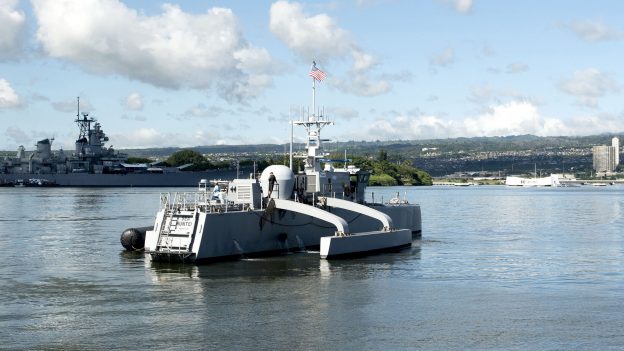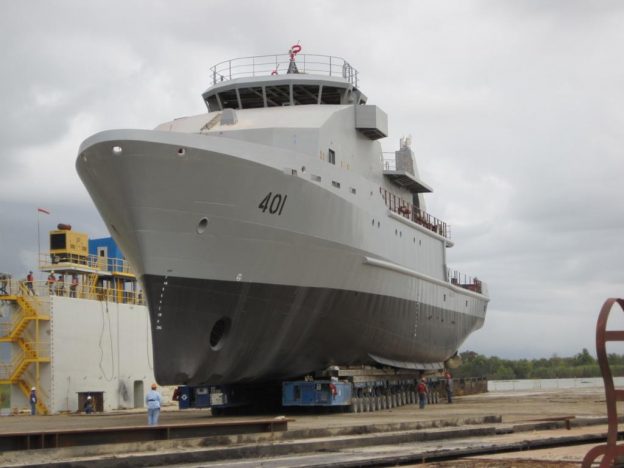The US Navy has tightly coupled early prototyping efforts and future acquisition efforts for medium and large unmanned surface vehicles, to speed up the time it will take to experiment with the vessels and get them fielded to fleet commanders, the program manager said last week.

Medium Displacement Unmanned Surface Vehicle (MDUSV) prototype Sea Hunter pulls into Joint Base Pearl Harbor-Hickam, Hawaii on Oct. 31, 2018. US Navy Photo
The Navy recently accelerated its timelines for fielding the Medium Unmanned Surface Vehicle (MUSV) and Large Unmanned Surface Vehicle (LUSV) – both of which were planned to be part of the Future Surface Combatant family of systems fielded in the 2020s, but have since been accelerated to Fiscal Year 2019 and 2020 acquisition dates, respectively.
Capt. Pete Small, unmanned maritime systems program manager (PMS 406) within the Program Executive Office for Unmanned and Small Combatants, said last week that there are still many questions to be answered about operating unmanned systems, but that the Navy would only figure out the answers once a larger number of vehicles were purchased, built and swimming around in the water.
Through ongoing prototyping efforts, “we’re getting key run-time. One of the things we will definitely need to do with all of these things is get many hours of operations,” Small said.
“Aggressively moving out, the Navy needs to and wants to acquire a good number of these medium and large USVs because that’s how we intend to deploy them, in numbers, and we need the hours so that we can develop the tactics, techniques and procedures on how we’re going to integrate them with those manned platforms to go deploy them.”
The Navy generated some controversy in its Fiscal Year 2020 budget request, which essentially sought to trade an aircraft carrier refueling and its remaining 25 years of service life for room in the budget to invest heavily in unmanned systems and other future weapons. Navy leaders have said that wargaming and studies point to unmanned as a key component of any future high-end battle, but in the surface domain, the Navy has thus far primarily invested in smaller USVs for the mine countermeasures mission set rather than larger vessels that can contribute to blue-water warfare.
Lawmakers have been skeptical that the Navy should invest in unproven unmanned systems at the expense of an aircraft carrier – freshman Rep. Elaine Luria (D-Va.), for example, said “I don’t think the president’s going to turn to the secretary of defense and say, ‘where are my unmanned surface vessels’ when a conflict breaks out in the world; they’re going to turn and ask, ‘where are my aircraft carriers?’” – and with the White House’s reversal of the decision to not refuel the carrier, it’s unclear how much money lawmakers will still devote to USV experimentation and fielding.
Still, Small said during a presentation at the Navy League’s annual Sea Air Space conference that the Navy needs to make these investments and get USVs in the water as soon as possible, to begin working through questions surrounding concepts of operations, policy and more, as well as to gain sailor confidence in the systems. If the money remains in the FY 2020 budget, Small said he’s ready to move quickly on his end.
“The reason we can [accelerate MUSV and LUSV acquisition] is because we’re leveraging a number of prototyping efforts, including the [Office of Naval Research] Sea Hunter program and also the [Strategic Capabilities Office] Overlord program,” he told USNI News during a question and answer period at his presentation.
“PMS 406 is actually executing the SCO Overlord program as their agent, so the people that are running that program are the same people that are in my office standing up the Medium USV program and the Large USV program. So there’s great commonality there and we’re ready to transition those prototypes directly into our plans.”

A Naval Sea Systems Command-developed Iraqi 60-meter Offshore Support Vessel. US Navy briefing material indicate that early versions of the service’s large unmanned surface vessels could be based on OSV designs. US Navy Photo
On both the medium and large vehicles, “similar to other shipbuilding programs, we’re working with PEO [Integrated Warfare Systems] in bringing in Navy program of record combat systems and program of record weapon systems to incorporate into our commercially-derived modular craft that we’re looking to procure,” Small said.
That use of existing command, control, communications, computers and intelligence (C4I) and weapons systems will further speed up the acquisition and fielding timeline, Small said. USNI News understands the Navy is already eyeing certain systems but has not made those public yet.
“There’s very much the intention to share commonality across the Medium USV and the Large USV platforms as part of that Future Surface Combatant force architecture. So from a C4I, command and control, logistics and sustainment – wherever we can, we’re looking for commonality across those programs,” Small said.
Small said during his presentation that the Future Surface Combatant force analysis of alternatives is ongoing and should wrap up by this fall. That AoA will further define the makeup of each piece of the family – MUSV, LUSV, the frigate and a large surface combatant – but Small’s program office is moving ahead and will incorporate the AoA’s decisions when they come out.
Small said his office is working with warfare centers around the country, as well as the Unmanned Underwater Vehicle Squadron (UUVRON) 1 in Keyport, Wash., to understand what the maintenance and logistics models might look like for these unmanned systems, what kind of manning they will need ashore to support them, what training those personnel will need and what training fleet operators will need to employ them smartly, and so on. When the Surface Developmental Squadron stands up soon, as a surface domain partner to UUVRON-1, Small’s office will work with them too to prepare for the arrival of MUSV and LUSV into the fleet. The SURFDEVRON’s work in the coming years on tactics, techniques and procedures will also further refine the Navy’s ideas about what payloads to integrate onto the unmanned ships.
“All of these things, we’re asking these questions and working with our various stakeholders to go address these things. But the point is, we’re starting to procure these things, we’re going into fabrication, they’re going to start coming off the production lines soon, and we need to have solid plans to go employ them, test them and field them so that we can get the military utility we want and we can efficiently and quickly learn how to incorporate these unmanned vehicles with other manned assets that we intend to go fight with,” Small said.
Also at Sea Air Space, other Navy leadership gave their pitches on the need to acquire USVs quickly.
“Every study directed or initiated from within has told us we have to move out on these capabilities,” Vice Adm. Bill Merz, the deputy chief of naval operations for warfare systems (OPNAV N9), said during a separate panel presentation.
“The stakes are high and we have to make sure the capability is real before we field it. And in no way should that be translated to we’re pumping the brakes on pursuing the capability – we just have to work through this,” he continued.
“And as the CNO likes to say, we’re a very evidence-based Navy, and so our commitment in our last budget to the tune of almost $3 billion in just unmanned surface vessels should be enough to signal to industry we’re very serious about this. And as soon as we can get this to a competitive environment, that should open up the window of the art of the possible with these vessels.”
Under Secretary of the Navy Thomas Modly told USNI News during a media roundtable at Sea Air Space that LUSV “is not anywhere near the cost of a regular ship, and so if you can up-arm it with missiles and things like that and have it be out there on patrols or hiding – those are the types of things, with no people on it , those are the types of missions it can do. We’re still in the process, we’re in this phase where we’re sort of experimenting and deploying at the same time, and I think that’s the nature of the business now. It’s just the way it is in industry, that’s the way it’s going to be for us. So we’re just trying to get capability out there, test it, experiment with it more rapidly than we did in the past.”

Common Unmanned Surface Vehicle. Textron photo.
Other Unmanned Systems Milestones
Though the LUSV program has dominated the conversation about unmanned systems since the FY 2020 budget proposal came out, the unmanned maritime systems program office is making significant progress on other vehicles in its portfolio.
On the surface side, the small Common USV, which was previously an acquisition category 3 program intended to haul an influence sweep system in the Littoral Combat Ship mine countermeasures mission package, has been upgraded to an ACAT 2 program and renamed the Mine Countermeasures USV. This development is a nod to a trend that is a few years in the works: as the Navy has increased its confidence in the CUSV platform, it has sought other missions for it beyond just minesweeping, including mine hunting.
Small said the MCM USV will reach Milestone C this quarter and begin low-rate initial production. Sonar integration for the mine hunting mission is upcoming, and the program office is also beginning development of a mine neutralizer to integrate onto the USV.
On the underwater side of the portfolio, the Snakehead Large Diameter UUV is set to go through its critical design review this quarter and then begin production of an operationally relevant prototype that will be in the water by FY 2021. This first variant of LDUUV will be integrated with an attack submarine via its dry deck shelter.
Small said the Navy is also interested in “larger and more capable variants of that Large Displacement UUV for further integration with Virginia Payload Module submarines and SSGNs.” This more-capable LDUUV will be put to industry through a request for proposals in DY 2020.
Additionally, the Navy is looking to expand the ways it employs the Razorback medium UUV. The UUV carries environment-sensing payloads and is launched and recovered via the dry deck shelter, like the LDUUV. Small said the Navy wants to develop a variant that is launched and recovered from the torpedo tube, and a solicitation for that UUV would go out in FY 2020.
The Orca Extra Large UUV just finished the first phase of its design, with the completion of its critical design review late last year. The Navy awarded Boeing a contract in February to build the first four vehicles, which Small said would deliver in calendar year 2020 through 2022 and would immediately be put into a rigorous test program.
The Knifefish medium UUV in the LCS MCM mission package will hit Milestone C and being low-rate initial production this quarter, Small said.